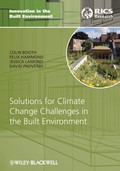Solutions for Climate Change Challenges in the Built Environment
Innovation in the Built Environment

1. Edition February 2012
368 Pages, Hardcover
Professional Book
Short Description
This book will develop an appreciation of the diverse, complex and current themes of the climate change debate across the built environment continuum. A multi-disciplinary perspective is provided through contributions from physical, environmental, social, economic and political scientists. This strategic view on built environment issues will be useful to researchers as well as policy experts and construction practitioners wanting a holistic view.
The multi-disciplinary perspective provided here offers a strategic view on built environment issues and improve understanding of how built environment activities potentially induce global warming and climate change. It also highlights solutions to these challenges.
Solutions to Climate change Challenges in the Built Environment helps develop an appreciation of the diverse themes of the climate change debate across the built environment continuum. A wide perspective is provided through contributions from physical, environmental, social, economic and political scientists. This strategic view on built environment issues will be useful to researchers as well as policy experts and construction practitioners wanting a holistic view.
This book clarifies complex issues around climate change and follows five main themes: climate change experiences; urban landscape development; urban management issues; measurement of impact; and the future. Chapters are written by eminent specialists from both academic and professional backgrounds. The main context for chapters is the developed world but the discussion is widened to incorporate regional issues.
The book will be valuable to researchers and students in all the built environment disciplines, as well as to practitioners involved with the design, construction and maintenance of buildings, and government organisations developing and implementing climate change policy.
Chapter 1 Introductory Insights to Climate Change Challenges
Chapter 2 Climate Change: Nature and Emerging Trends
Chapter 3 Regional Implications
Chapter 4 Urbanization and Climate Change
Chapter 5 Global Political Initiatives and Overtones
Chapter 6 Green Economics Dialogue and the Built Environment
Chapter 7 Strategic Environmental Impact Assessment
Chapter 8 Methods for Valuing Preferences for Environmental and Natural Resources: An Overview
Chapter 9 Ecological value of Urban Environments
Chapter 10 The Pedological Value of Urban Landscapes
Chapter 11 Insights and Perceptions of Sustainable Design and Construction
Chapter 12 Progress in Eco-and Resilient-Construction Materials Development
Chapter 13 Energy Efficiency: Alternative Routes to Mitigation
Chapter 14 The Benefits of Green Infrastructure in Towns and Cities
Chapter 15 Particulate Induced Soiling on Historic Limestone Buildings: Insights and the Effects of Climate Change
Chapter 16 Sustainable Transportation
Chapter 17 Linkages of Waste Management Strategies and Climate Change Issues
Chapter 18 Climate Change and the Geotechnical Stability of 'Engineered'Landfill Sites
Chapter 19 Water Resources Issues and Solutions for the Built Environment: too little versus too much
Chapter 20 Organisational Culture and Climate Change Driven Construction
Chapter 21 Preparing for Extreme weather events: A Risk Assessment Approach
Chapter 22 The Socio-environmental Vulnerability Assessment Approach to Mapping Vulnerability to Climate
Chapter 23 Mitigation via Renewables
Chapter 24 Complexities and Approaches to Managing the Adaptation of Climate Change by Coastal Communities
Chapter 25 Lessons for the Future
Index
Felix N. Hammond, Lecturer, Construction and Infrastructure, School of Engineering and the Built Environment, University of Wolverhampton
Jessica Lamond, Post Doctoral Research Fellow, Construction and Infrastructure, School of Engineering and the Built Environment, University of Wolverhampton
David G. Proverbs, Professor and Head of Department, Construction and Property, Faculty of Environment and Technology, University of the West of England


